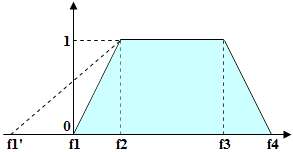Skip to main contentA Fuzzy interval is a tool that enables the program to assess the quality of a hypothesis based on its length. A fuzzy interval may be measured in units of length (dots, millimeters, etc.) or in characters (in the case of lines). For a fuzzy interval, four values must be specified which determine the possible and optimal range of values. For the purpose of simplification, an easy-to-use fuzzy interval editor is provided in the program.
Suppose you have a fuzzy interval {f1,f2,f3,f4} and the length of the detected string (in characters, or dots for a detected space) is L. If the length L is in the range from f2 to f3 (i.e. L>=f2 and L<=f3), the quality of the hypothesis is 1. If the length is in the range from f1 to f2, the quality of the hypothesis changes in direct proportion from 0 to 1 (Quality(f1) = 0, Quality(f2)=1). Similarly, if the length is in the range from f3 to f4, the quality of the hypothesis changer in direct proportion from 1 to 0 (Quality(f3) = 1, Quality(f4) = 0). If the length does not fall in the range from f1 to f4 (i.e. Lf4), the quality of the hypothesis is 0 (Quality(L) = 0). The quality of the hypothesis for the detected object is multiplied by the values of the Character count property, which is selected depending on the length of the detected object.

Note: The quality of any chain of hypotheses for several elements is calculated by multiplying the hypotheses for each element in the chain. If the chain is sufficiently long and the quality estimates of the constituent hypotheses are too low due to the restrictions being too strict, the resulting quality of the entire chain may be too low as well.
Therefore, it is recommended to make sure that the selected hypothesis has the highest quality estimate possible. On the other hand, you need to be able to distinguish hypotheses by their qualities, so as to be able to select the best one. Therefore, you need to set up fuzzy intervals (which are mathematical functions for hypothesis evaluation) in such a way so that acceptable hypotheses are not penalized too much.
Negative values can also be used for the left boundary of the fuzzy interval (even though in reality there are no strings of negative length). This may be useful for making the quality graph less steep on the (0, 1) interval, thereby reducing the quality penalty. If you need to set a bottom limit for this parameter (e.g. the length of the string cannot be smaller than 10 characters with the fuzzy interval for the length of the string being [-10,20,30,40}), you can do so directly in Hypothesis Evaluation by setting Value.Length >=10.
 We do not recommend making the interval boundaries too strict. This is particularly important when processing images of varying quality. On some images for example, there may be spaces with letters due to the poor quality of the source document or the particular scanning options. In this case, the program may interpret one character as several characters, which may lead to a drastic decrease in the quality of the hypothesis if the interval was overly strict. As a result, the program may discard that hypothesis (which could have been correct in essence) and select a different one. For this reason, if you need to select between hypotheses by comparing their lengths, this should be done using additional conditions in Hypothesis Evaluation.
We do not recommend making the interval boundaries too strict. This is particularly important when processing images of varying quality. On some images for example, there may be spaces with letters due to the poor quality of the source document or the particular scanning options. In this case, the program may interpret one character as several characters, which may lead to a drastic decrease in the quality of the hypothesis if the interval was overly strict. As a result, the program may discard that hypothesis (which could have been correct in essence) and select a different one. For this reason, if you need to select between hypotheses by comparing their lengths, this should be done using additional conditions in Hypothesis Evaluation. 

